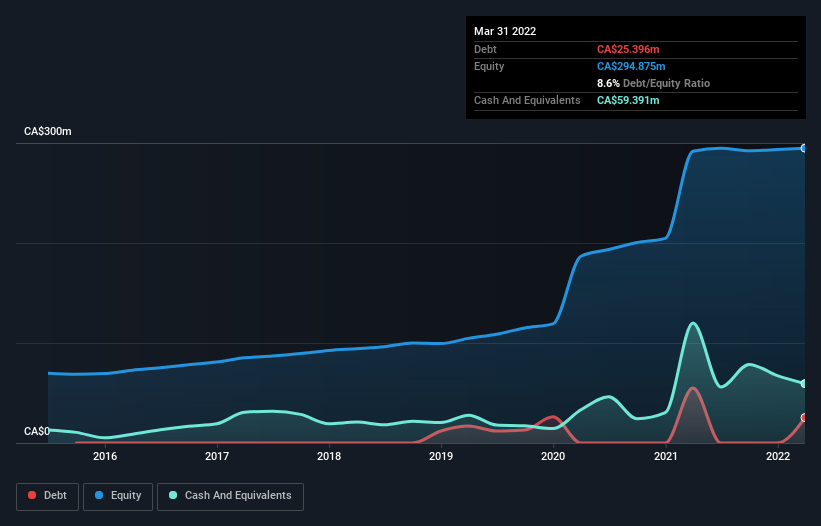These 4 Measures Indicate That Calian Group (TSE:CGY) Is Using Debt Safely
Legendary fund manager Li Lu (who Charlie Munger backed) once said, 'The biggest investment risk is not the volatility of prices, but whether you will suffer a permanent loss of capital.' So it seems the smart money knows that debt - which is usually involved in bankruptcies - is a very important factor, when you assess how risky a company is. As with many other companies Calian Group Ltd. (TSE:CGY) makes use of debt. But the real question is whether this debt is making the company risky.
Why Does Debt Bring Risk?
Debt assists a business until the business has trouble paying it off, either with new capital or with free cash flow. If things get really bad, the lenders can take control of the business. However, a more usual (but still expensive) situation is where a company must dilute shareholders at a cheap share price simply to get debt under control. By replacing dilution, though, debt can be an extremely good tool for businesses that need capital to invest in growth at high rates of return. The first step when considering a company's debt levels is to consider its cash and debt together.
View our latest analysis for Calian Group
What Is Calian Group's Net Debt?
As you can see below, Calian Group had CA$25.4m of debt at March 2022, down from CA$55.0m a year prior. However, it does have CA$59.4m in cash offsetting this, leading to net cash of CA$34.0m.
A Look At Calian Group's Liabilities
Zooming in on the latest balance sheet data, we can see that Calian Group had liabilities of CA$232.0m due within 12 months and liabilities of CA$36.4m due beyond that. Offsetting these obligations, it had cash of CA$59.4m as well as receivables valued at CA$211.8m due within 12 months. So these liquid assets roughly match the total liabilities.
Having regard to Calian Group's size, it seems that its liquid assets are well balanced with its total liabilities. So while it's hard to imagine that the CA$757.3m company is struggling for cash, we still think it's worth monitoring its balance sheet. Succinctly put, Calian Group boasts net cash, so it's fair to say it does not have a heavy debt load!
The good news is that Calian Group has increased its EBIT by 7.7% over twelve months, which should ease any concerns about debt repayment. There's no doubt that we learn most about debt from the balance sheet. But ultimately the future profitability of the business will decide if Calian Group can strengthen its balance sheet over time. So if you're focused on the future you can check out this free report showing analyst profit forecasts.
Finally, a company can only pay off debt with cold hard cash, not accounting profits. While Calian Group has net cash on its balance sheet, it's still worth taking a look at its ability to convert earnings before interest and tax (EBIT) to free cash flow, to help us understand how quickly it is building (or eroding) that cash balance. During the last three years, Calian Group produced sturdy free cash flow equating to 68% of its EBIT, about what we'd expect. This cold hard cash means it can reduce its debt when it wants to.
Summing up
While we empathize with investors who find debt concerning, you should keep in mind that Calian Group has net cash of CA$34.0m, as well as more liquid assets than liabilities. The cherry on top was that in converted 68% of that EBIT to free cash flow, bringing in CA$43m. So we don't think Calian Group's use of debt is risky. When analysing debt levels, the balance sheet is the obvious place to start. However, not all investment risk resides within the balance sheet - far from it. Case in point: We've spotted 3 warning signs for Calian Group you should be aware of.
Of course, if you're the type of investor who prefers buying stocks without the burden of debt, then don't hesitate to discover our exclusive list of net cash growth stocks, today.
Have feedback on this article? Concerned about the content? Get in touch with us directly. Alternatively, email editorial-team (at) simplywallst.com.
This article by Simply Wall St is general in nature. We provide commentary based on historical data and analyst forecasts only using an unbiased methodology and our articles are not intended to be financial advice. It does not constitute a recommendation to buy or sell any stock, and does not take account of your objectives, or your financial situation. We aim to bring you long-term focused analysis driven by fundamental data. Note that our analysis may not factor in the latest price-sensitive company announcements or qualitative material. Simply Wall St has no position in any stocks mentioned.

